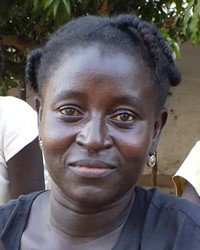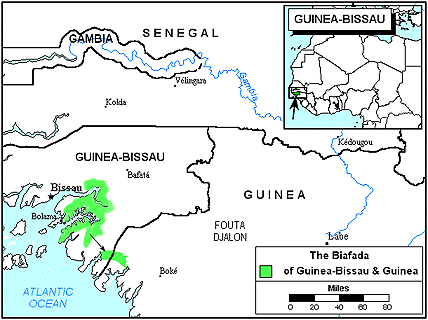The Biafada of Guinea-Bissau are commonly regarded as a sub-group of the Tenda. They are spread over a wide area, a small group located on the north bank of the Geba river (Gool dialect), the two large groups (dialects of Guinala and Bubwas) in the province of Quinará, south western part of the country, and another small group, detached from the others, in the southernmost province of Tombali, extending over the border into Guinea Conakry, the Bagandada dialect.
Most of Guinea-Bissau is a low-lying, swampy coastal plain. The land rises gradually to form a plateau region in the east. The maximum elevation of about 1,017 feet is found in the southeast. Within the country, there are about 37 different ethnic groups, the major ones being the Balante, the Fulani, the Papel, the Mandinka, and the Mandyak. Cape Verdians form a small but significant, minority. The Biafada speak a Niger-Congo language that is also known as Biafada. (In their own language it is called Ganjoola and they name themselves Bijoola.)
Like most of the people in West Africa, the Biafada are farmers. They grow a variety of crops, using very basic tools. Maize, manioc, and rice are the staples, but squash, melons, sweet potatoes, peppers and tomatoes are also grown. Major tree crops include cashew nuts, bananas, mangoes and papayas. The Biafada raise sheep and goats but do not use their milk. Hunting is of less importance than agriculture, but there is considerable gathering of wild fruits and roots, berries, and kola, shea and palm nuts.
Their houses are rectangular. They do not live in compound clusters, but in villages, although family live often in adjoining houses. The villages are generally rectangular. There is generally one house of the village elder at one end of the rectangle; sometimes this place was occupied by the mosque. In recent years this model has changed as the Biafadas tend to build their villages along both sides of a road, with traffic going through the middle of the villages. There aren't any mud walls or fences around compounds or villages.
In the Biafada community, men hunt, fish and clear the land. The women do the gathering and help in the agricultural work.
There is generally a village elder or chief, considered as the person of authority. There used to be a structure with chieftains governing larger areas. This had all but disappeared during the colonial days and the war of independence. In some areas it is in the process of being reinstated, though it's influence is limited to matters pertaining to traditional land rights and such.
They circumcise males as part of an initiation ceremonies at puberty. It typically involve a period of instruction in an isolated "bush school." In family right there were always heavy punishments known as 'justisa di minjer' (literally: 'women's justice') for premarital sex resulting in pregnancy, both for the male and the female offender. This was outlawed by the government in the seventies. Nowadays there is a lot of promiscuity, resulting in many children born outside wedlock and also in an increasing percentage of HIV.
Polygyny is very common among the Biafada, probably encouraged by their conversion to Islam. The man and his different wives all live in the same house, with each wife generally having her own room.
The Biafada are nearly 100% Sunni Muslims, having gone over to Islam over the past century. Underneath, many still practice old animist rites to some extent, though they will seldom admit it. Their believe is a mixture of Islamic doctrine and animistic beliefs. Their Islamic believes and practices have been considerably strengthened over the past 30 years, turning them into staunch Muslims.
Although there are undoubtedly a few Biafada Roman Catholics in the capital Bissau, the Roman Catholic church has not made any inroads among them in the tribal areas. There are about a dozen known evangelical/protestant Biafada believers, all but four or five of them living outside Biafada territory.
There isn't a Biafada church. Though there are a number of churches in the Biafada territory due to the fact that the population is very mixed, Biafada are not attracted to these churches as they consist mainly of people from animistic background. Pork consumption and the use of drums in the church generally prevent any really interest in the evangelical churches from the side of the Biafada. As it stands there are only Bible portions in their language.
Ask the Lord of the harvest to send additional laborers to work among the Biafada of Guinea-Bissau.
Ask the Lord to save key leaders among the Biafada who will openly proclaim the gospel.
Pray that God will give the Biafada believers boldness and love to share Christ with their own people.
Ask God to raise prayer teams who will begin breaking up the soil through worship and intercession.
Ask the Lord to bring forth a strong Biafada church for the glory of his name.
Scripture Prayers for the Biafada in Guinea-Bissau.
Profile updated with field information in 2012
| Profile Source: Joshua Project |











